| Marks available | 17 |
| Reference code | 09M.3srg.hl.TZ0.1 |
Question
(a) Show that {1, −1, i, −i} forms a group of complex numbers G under multiplication.
(b) Consider \(S = \{ e,{\text{ }}a,{\text{ }}b,{\text{ }}a * b\} \) under an associative operation \( * \) where e is the identity element. If \(a * a = b * b = e\) and \(a * b = b * a\) , show that
(i) \(a * b * a = b\) ,
(ii) \(a * b * a * b = e\) .
(c) (i) Write down the Cayley table for \(H = \{ S{\text{ , }} * \} \).
(ii) Show that H is a group.
(iii) Show that H is an Abelian group.
(d) For the above groups, G and H , show that one is cyclic and write down why the other is not. Write down all the generators of the cyclic group.
(e) Give a reason why G and H are not isomorphic.
Markscheme
(a)
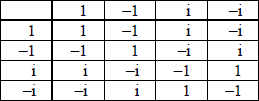
see the Cayley table, (since there are no new elements) the set is closed A1
1 is the identity element A1
1 and –1 are self inverses and i and -i form an inverse pair, hence every element has an inverse A1
multiplication is associative A1
hence {1, –1, i, –i} form a group G under the operation of multiplication AG
[4 marks]
(b) (i) aba = aab
= eb A1
= b AG
(ii) abab = aabb
= ee A1
= e AG
[2 marks]
(c) (i)
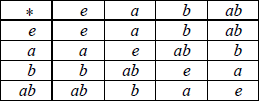 A2
A2
Note: Award A1 for 1 or 2 errors, A0 for more than 2.
(ii) see the Cayley table, (since there are no new elements) the set is closed A1
H has an identity element e A1
all elements are self inverses, hence every element has an inverse A1
the operation is associative as stated in the question
hence {e , a , b , ab} forms a group G under the operation \( * \) AG
(iii) since there is symmetry across the leading diagonal of the group table, the group is Abelian A1
[6 marks]
(d) consider the element i from the group G (M1)
\({{\text{i}}^2} = – 1\)
\({{\text{i}}^3} = – {\text{i}}\)
\({{\text{i}}^4} = 1\)
thus i is a generator for G and hence G is a cyclic group A1
–i is the other generator for G A1
for the group H there is no generator as all the elements are self inverses R1
[4 marks]
(e) since one group is cyclic and the other group is not, they are not isomorphic R1
[1 mark]
Total [17 marks]
Examiners report
Most candidates were aware of the group axioms and the properties of a group, but they were not always explained clearly. A number of candidates did not understand the term “Abelian”. Many candidates understood the conditions for a group to be cyclic. Many candidates did not realise that the answer to part (e) was actually found in part (d), hence the reason for this part only being worth 1 mark. Overall, a number of fully correct solutions to this question were seen.
| Marks available | 20 |
| Reference code | 10N.3srg.hl.TZ0.4 |
Question
Set \(S = \{ {x_0},{\text{ }}{x_1},{\text{ }}{x_2},{\text{ }}{x_3},{\text{ }}{x_4},{\text{ }}{x_5}\} \) and a binary operation \( \circ \) on S is defined as \({x_i} \circ {x_j} = {x_k}\), where \(i + j \equiv k(\bmod 6)\).
(a) (i) Construct the Cayley table for \(\{ S,{\text{ }} \circ \} \) and hence show that it is a group.
(ii) Show that \(\{ S,{\text{ }} \circ \} \) is cyclic.
(b) Let \(\{ G,{\text{ }} * \} \) be an Abelian group of order 6. The element \(a \in {\text{G}}\) has order 2 and the element \(b \in {\text{G}}\) has order 3.
(i) Write down the six elements of \(\{ G,{\text{ }} * \} \).
(ii) Find the order of \({\text{a}} * b\) and hence show that \(\{ G,{\text{ }} * \} \) is isomorphic to \(\{ S,{\text{ }} \circ \} \).
Markscheme
(a) (i) Cayley table for \(\{ S,{\text{ }} \circ \} \)
\(\begin{array}{*{20}{c|cccccc}}
\circ &{{x_0}}&{{x_1}}&{{x_2}}&{{x_3}}&{{x_4}}&{{x_5}} \\
\hline
{{x_0}}&{{x_0}}&{{x_1}}&{{x_2}}&{{x_3}}&{{x_4}}&{{x_5}} \\
{{x_1}}&{{x_1}}&{{x_2}}&{{x_3}}&{{x_4}}&{{x_5}}&{{x_0}} \\
{{x_2}}&{{x_2}}&{{x_3}}&{{x_4}}&{{x_5}}&{{x_0}}&{{x_1}} \\
{{x_3}}&{{x_3}}&{{x_4}}&{{x_5}}&{{x_0}}&{{x_1}}&{{x_2}} \\
{{x_4}}&{{x_4}}&{{x_5}}&{{x_0}}&{{x_1}}&{{x_2}}&{{x_3}} \\
{{x_5}}&{{x_5}}&{{x_0}}&{{x_1}}&{{x_2}}&{{x_3}}&{{x_4}}
\end{array}\) A4
Note: Award A4 for no errors, A3 for one error, A2 for two errors, A1 for three errors and A0 for four or more errors.
S is closed under \( \circ \) A1
\({x_0}\) is the identity A1
\({x_0}\) and \({x_3}\) are self-inverses, A1
\({x_2}\) and \({x_4}\) are mutual inverses and so are \({x_1}\) and \({x_5}\) A1
modular addition is associative A1
hence, \(\{ S,{\text{ }} \circ \} \) is a group AG
(ii) the order of \({x_1}\) (or \({x_5}\)) is 6, hence there exists a generator, and \(\{ S,{\text{ }} \circ \} \) is a cyclic group A1R1
[11 marks]
(b) (i) e, a, b, ab A1
and \({b^2},{\text{ }}a{b^2}\) A1A1
Note: Accept \(ba\) and \({b^2}a\).
(ii) \({(ab)^2} = {b^2}\) M1A1
\({(ab)^3} = a\) A1
\({(ab)^4} = b\) A1
hence order is 6 A1
groups G and S have the same orders and both are cyclic R1
hence isomorphic AG
[9 marks]
Total [20 marks]
Examiners report
a) Most candidates had the correct Cayley table and were able to show successfully that the group axioms were satisfied. Some candidates, however, simply stated that an inverse exists for each element without stating the elements and their inverses. Most candidates were able to find a generator and hence show that the group is cyclic.
b) This part was answered less successfully by many candidates. Some failed to find all the elements. Some stated that the order of ab is 6 without showing any working.
| Marks available | 2 |
| Reference code | 12M.3srg.hl.TZ0.1 |
Question
Associativity and commutativity are two of the five conditions for a set S with the binary operation \( * \) to be an Abelian group; state the other three conditions.
The Cayley table for the binary operation \( \odot \) defined on the set T = {p, q, r, s, t} is given below.
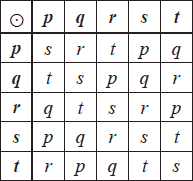
(i) Show that exactly three of the conditions for {T , \( \odot \)} to be an Abelian group are satisfied, but that neither associativity nor commutativity are satisfied.
(ii) Find the proper subsets of T that are groups of order 2, and comment on your result in the context of Lagrange’s theorem.
(iii) Find the solutions of the equation \((p \odot x) \odot x = x \odot p\) .
Markscheme
closure, identity, inverse A2
Note: Award A1 for two correct properties, A0 otherwise.
[2 marks]
(i) closure: there are no extra elements in the table R1
identity: s is a (left and right) identity R1
inverses: all elements are self-inverse R1
commutative: no, because the table is not symmetrical about the leading diagonal, or by counterexample R1
associativity: for example, \((pq)t = rt = p\) M1A1
not associative because \(p(qt) = pr = t \ne p\) R1
Note: Award M1A1 for 1 complete example whether or not it shows non-associativity.
(ii) \(\{ s,\,p\} ,{\text{ }}\{ s,\,q\} ,{\text{ }}\{ s,\,r\} ,{\text{ }}\{ s,\,t\} \) A2
Note: Award A1 for 2 or 3 correct sets.
as 2 does not divide 5, Lagrange’s theorem would have been contradicted if T had been a group R1
(iii) any attempt at trying values (M1)
the solutions are q, r, s and t A1A1A1A1
Note: Deduct A1 if p is included.
[15 marks]
Examiners report
This was on the whole a well answered question and it was rare for a candidate not to obtain full marks on part (a). In part (b) the vast majority of candidates were able to show that the set satisfied the properties of a group apart from associativity which they were also familiar with. Virtually all candidates knew the difference between commutativity and associativity and were able to distinguish between the two. Candidates were familiar with Lagrange’s Theorem and many were able to see how it did not apply in the case of this problem. Many candidates found a solution method to part (iii) of the problem and obtained full marks.
This was on the whole a well answered question and it was rare for a candidate not to obtain full marks on part (a). In part (b) the vast majority of candidates were able to show that the set satisfied the properties of a group apart from associativity which they were also familiar with. Virtually all candidates knew the difference between commutativity and associativity and were able to distinguish between the two. Candidates were familiar with Lagrange’s Theorem and many were able to see how it did not apply in the case of this problem. Many candidates found a solution method to part (iii) of the problem and obtained full marks.
| Marks available | 15 |
| Reference code | 12M.3srg.hl.TZ0.1 |
Question
Associativity and commutativity are two of the five conditions for a set S with the binary operation \( * \) to be an Abelian group; state the other three conditions.
The Cayley table for the binary operation \( \odot \) defined on the set T = {p, q, r, s, t} is given below.
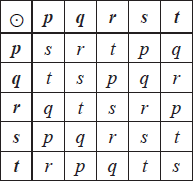
(i) Show that exactly three of the conditions for {T , \( \odot \)} to be an Abelian group are satisfied, but that neither associativity nor commutativity are satisfied.
(ii) Find the proper subsets of T that are groups of order 2, and comment on your result in the context of Lagrange’s theorem.
(iii) Find the solutions of the equation \((p \odot x) \odot x = x \odot p\) .
Markscheme
closure, identity, inverse A2
Note: Award A1 for two correct properties, A0 otherwise.
[2 marks]
(i) closure: there are no extra elements in the table R1
identity: s is a (left and right) identity R1
inverses: all elements are self-inverse R1
commutative: no, because the table is not symmetrical about the leading diagonal, or by counterexample R1
associativity: for example, \((pq)t = rt = p\) M1A1
not associative because \(p(qt) = pr = t \ne p\) R1
Note: Award M1A1 for 1 complete example whether or not it shows non-associativity.
(ii) \(\{ s,\,p\} ,{\text{ }}\{ s,\,q\} ,{\text{ }}\{ s,\,r\} ,{\text{ }}\{ s,\,t\} \) A2
Note: Award A1 for 2 or 3 correct sets.
as 2 does not divide 5, Lagrange’s theorem would have been contradicted if T had been a group R1
(iii) any attempt at trying values (M1)
the solutions are q, r, s and t A1A1A1A1
Note: Deduct A1 if p is included.
[15 marks]
Examiners report
This was on the whole a well answered question and it was rare for a candidate not to obtain full marks on part (a). In part (b) the vast majority of candidates were able to show that the set satisfied the properties of a group apart from associativity which they were also familiar with. Virtually all candidates knew the difference between commutativity and associativity and were able to distinguish between the two. Candidates were familiar with Lagrange’s Theorem and many were able to see how it did not apply in the case of this problem. Many candidates found a solution method to part (iii) of the problem and obtained full marks.
This was on the whole a well answered question and it was rare for a candidate not to obtain full marks on part (a). In part (b) the vast majority of candidates were able to show that the set satisfied the properties of a group apart from associativity which they were also familiar with. Virtually all candidates knew the difference between commutativity and associativity and were able to distinguish between the two. Candidates were familiar with Lagrange’s Theorem and many were able to see how it did not apply in the case of this problem. Many candidates found a solution method to part (iii) of the problem and obtained full marks.
| Marks available | 7 |
| Reference code | 15N.3srg.hl.TZ0.4 |
Question
The binary operation \( * \) is defined on the set \(T = \{ 0,{\text{ }}2,{\text{ }}3,{\text{ }}4,{\text{ }}5,{\text{ }}6\} \) by \(a * b = (a + b – ab)(\bmod 7),{\text{ }}a,{\text{ }}b \in T\).
Copy and complete the following Cayley table for \(\{ T,{\text{ }} * \} \).
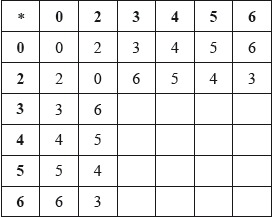
Prove that \(\{ T,{\text{ }} * \} \) forms an Abelian group.
Find the order of each element in \(T\).
Given that \(\{ H,{\text{ }} * \} \) is the subgroup of \(\{ T,{\text{ }} * \} \) of order \(2\), partition \(T\) into the left cosets with respect to \(H\).
Markscheme
Cayley table is
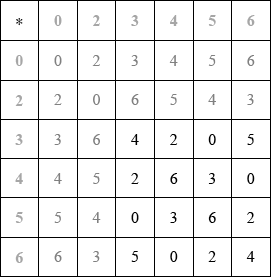 A4
A4
award A4 for all 16 correct, A3 for up to 2 errors, A2 for up to 4 errors, A1 for up to 6 errors
[4 marks]
closed as no other element appears in the Cayley table A1
symmetrical about the leading diagonal so commutative R1
hence it is Abelian
\(0\) is the identity
as \(x * 0( = 0 * x) = x + 0 – 0 = x\) A1
\(0\) and \(2\) are self inverse, \(3\) and \(5\) is an inverse pair, \(4\) and \(6\) is an inverse pair A1
Note: Accept “Every row and every column has a \(0\) so each element has an inverse”.
\((a * b) * c = (a + b – ab) * c = a + b – ab + c – (a + b – ab)c\) M1
\( = a + b + c – ab – ac – bc + abc\) A1
\(a * (b * c) = a * (b + c – bc) = a + b + c – bc – a(b + c – bc)\) A1
\( = a + b + c – ab – ac – bc + abc\)
so \((a * b) * c = a * (b * c)\) and \( * \) is associative
Note: Inclusion of mod 7 may be included at any stage.
[7 marks]
\(0\) has order \(1\) and \(2\) has order \(2\) A1
\({3^2} = 4,{\text{ }}{3^3} = 2,{\text{ }}{3^4} = 6,{\text{ }}{3^5} = 5,{\text{ }}{3^6} = 0\) so \(3\) has order \(6\) A1
\({4^2} = 6,{\text{ }}{4^3} = 0\) so \(4\) has order \(3\) A1
\(5\) has order \(6\) and \(6\) has order \(3\) A1
[4 marks]
\(H = \{ 0,{\text{ }}2\} \) A1
\(0 * \{ 0,{\text{ }}2\} = \{ 0,{\text{ }}2\} ,{\text{ }}2 * \{ 0,{\text{ }}2\} = \{ 2,{\text{ }}0\} ,{\text{ }}3 * \{ 0,{\text{ }}2\} = \{ 3,{\text{ }}6\} ,{\text{ }}4 * \{ 0,{\text{ }}2\} = \{ 4,{\text{ }}5\} ,\)
\(5 * \{ 0,{\text{ }}2\} = \{ 5,{\text{ }}4\} ,{\text{ }}6 * \{ 0,{\text{ }}2\} = \{ 6,{\text{ }}3\} \) M1
Note: Award the M1 if sufficient examples are used to find at least two of the cosets.
so the left cosets are \(\{ 0,{\text{ }}2\} ,{\text{ }}\{ 3,{\text{ }}6\} ,{\text{ }}\{ 4,{\text{ }}5\} \) A1
[3 marks]
Total [18 marks]
Examiners report
| Marks available | 5 |
| Reference code | 16M.3srg.hl.TZ0.1 |
Question
The following Cayley table for the binary operation multiplication modulo 9, denoted by \( * \), is defined on the set \(S = \{ 1,{\text{ }}2,{\text{ }}4,{\text{ }}5,{\text{ }}7,{\text{ }}8\} \).
Copy and complete the table.
Show that \(\{ S,{\text{ }} * \} \) is an Abelian group.
Determine the orders of all the elements of \(\{ S,{\text{ }} * \} \).
(i) Find the two proper subgroups of \(\{ S,{\text{ }} * \} \).
(ii) Find the coset of each of these subgroups with respect to the element 5.
Solve the equation \(2 * x * 4 * x * 4 = 2\).
Markscheme
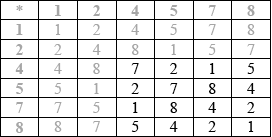 A3
A3
Note: Award A3 for correct table, A2 for one or two errors, A1 for three or four errors and A0 otherwise.
[3 marks]
the table contains only elements of \(S\), showing closure R1
the identity is 1 A1
every element has an inverse since 1 appears in every row and column, or a complete list of elements and their correct inverses A1
multiplication of numbers is associative A1
the four axioms are satisfied therefore \(\{ S,{\text{ }} * \} \) is a group
the group is Abelian because the table is symmetric (about the leading diagonal) A1
[5 marks]
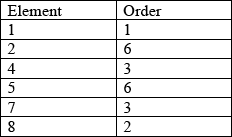 A3
A3
Note: Award A3 for all correct values, A2 for 5 correct, A1 for 4 correct and A0 otherwise.
[3 marks]
(i) the subgroups are \(\{ 1,{\text{ }}8\} \); \(\{ 1,{\text{ }}4,{\text{ }}7\} \) A1A1
(ii) the cosets are \(\{ 4,{\text{ }}5\} \); \(\{ 2,{\text{ }}5,{\text{ }}8\} \) A1A1
[4 marks]
METHOD 1
use of algebraic manipulations M1
and at least one result from the table, used correctly A1
\(x = 2\) A1
\(x = 7\) A1
METHOD 2
testing at least one value in the equation M1
obtain \(x = 2\) A1
obtain \(x = 7\) A1
explicit rejection of all other values A1
[4 marks]
Examiners report
The majority of candidates were able to complete the Cayley table correctly.
Generally well done. However, it is not good enough for a candidate to say something along the lines of ‘the operation is closed or that inverses exist by looking at the Cayley table’. A few candidates thought they only had to prove commutativity.
Often well done. A few candidates stated extra, and therefore incorrect subgroups.
The majority found only one solution, usually the obvious \(x = 2\), but sometimes only the less obvious \(x = 7\).
| Marks available | 9 |
| Reference code | 17M.3srg.hl.TZ0.4 |
Question
The binary operation \( * \) is defined by
\(a * b = a + b – 3\) for \(a,{\text{ }}b \in \mathbb{Z}\).
The binary operation \( \circ \) is defined by
\(a \circ b = a + b + 3\) for \(a,{\text{ }}b \in \mathbb{Z}\).
Consider the group \(\{ \mathbb{Z},{\text{ }} \circ {\text{\} }}\) and the bijection \(f:\mathbb{Z} \to \mathbb{Z}\) given by \(f(a) = a – 6\).
Show that \(\{ \mathbb{Z},{\text{ }} * \} \) is an Abelian group.
Show that there is no element of order 2.
Find a proper subgroup of \(\{ \mathbb{Z},{\text{ }} * \} \).
Show that the groups \(\{ \mathbb{Z},{\text{ }} * \} \) and \(\{ \mathbb{Z},{\text{ }} \circ \} \) are isomorphic.
Markscheme
closure: \(\{ \mathbb{Z},{\text{ }} * \} \) is closed because \(a + b – 3 \in \mathbb{Z}\) R1
identity: \(a * e = a + e – 3 = a\) (M1)
\(e = 3\) A1
inverse: \(a * {a^{ – 1}} = a + {a^{ – 1}} – 3 = 3\) (M1)
\({a^{ – 1}} = 6 – a\) A1
associative: \(a * (b * c) = a * (b + c – 3) = a + b + c – 6\) A1
\(\left( {a{\text{ }}*{\text{ }}b} \right){\text{ }}*{\text{ }}c{\text{ }} = \left( {a{\text{ }} + {\text{ }}b{\text{ }} – {\text{ }}3} \right)*{\text{ }}c{\text{ }} = {\text{ }}a{\text{ }} + {\text{ }}b{\text{ }} + {\text{ }}c{\text{ }} – {\text{ }}6\) A1
associative because \(a * (b * c) = (a * b) * c\) R1
\(b * a = b + a – 3 = a + b – 3 = a * b\) therefore commutative hence Abelian R1
hence \(\{ \mathbb{Z},{\text{ }} * \} \) is an Abelian group AG
[9 marks]
if \(a\) is of order 2 then \(a * a = 2a – 3 = 3\) therefore \(a = 3\) A1
which is a contradiction
since \(e = 3\) and has order 1 R1
Note: R1 for recognising that the identity has order 1.
[2 marks]
for example \(S = \{ – 6,{\text{ }} – 3,{\text{ }}0,{\text{ }}3,{\text{ }}6 \ldots \} \) or \(S = \{ \ldots ,{\text{ }} – 1,{\text{ }}1,{\text{ }}3,{\text{ }}5,{\text{ }}7 \ldots \} \) A1R1
Note: R1 for deducing, justifying or verifying that \(\left\{ {S, * } \right\}\) is indeed a proper subgroup.
[2 marks]
we need to show that \(f(a * b) = f(a) \circ f(b)\) R1
\(f(a * b) = f(a + b – 3) = a + b – 9\) A1
\(f(a) \circ f(b) = (a – 6) \circ (b – 6) = a + b – 9\) A1
hence isomorphic AG
Note: R1 for recognising that \(f\) preserves the operation; award R1A0A0 for an attempt to show that \(f(a \circ b) = f(a) * f(b)\).
[3 marks]
Examiners report
| Marks available | 4 |
| Reference code | 18M.3srg.hl.TZ0.1 |
Question
The binary operation multiplication modulo 10, denoted by ×10, is defined on the set T = {2 , 4 , 6 , 8} and represented in the following Cayley table.
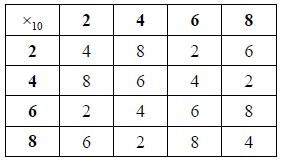
Show that {T, ×10} is a group. (You may assume associativity.)
By making reference to the Cayley table, explain why T is Abelian.
Find the order of each element of {T, ×10}.
Hence show that {T, ×10} is cyclic and write down all its generators.
The binary operation multiplication modulo 10, denoted by ×10 , is defined on the set V = {1, 3 ,5 ,7 ,9}.
Show that {V, ×10} is not a group.
Markscheme
closure: there are no new elements in the table A1
identity: 6 is the identity element A1
inverse: every element has an inverse because there is a 6 in every row and column (2−1 = 8, 4−1 = 4, 6−1 = 6, 8−1 = 2) A1
we are given that (modulo) multiplication is associative R1
so {T, ×10} is a group AG
[4 marks]
the Cayley table is symmetric (about the main diagonal) R1
so T is Abelian AG
[1 mark]
considering powers of elements (M1)
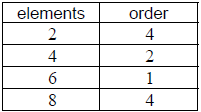 A2
A2
Note: Award A2 for all correct and A1 for one error.
[3 marks]
EITHER
{T, ×10} is cyclic because there is an element of order 4 R1
Note: Accept “there are elements of order 4”.
OR
{T, ×10} is cyclic because there is generator R1
Note: Accept “because there are generators”.
THEN
2 and 8 are generators A1A1
[3 marks]
EITHER
considering singular elements (M1)
5 has no inverse (5 ×10 a = 1, a∈V has no solution) R1
OR
considering Cayley table for {V, ×10}
 M1
M1
the Cayley table is not a Latin square (or equivalent) R1
OR
considering cancellation law
eg, 5 ×10 9 = 5 ×10 1 = 5 M1
if {V, ×10} is a group the cancellation law gives 9 = 1 R1
OR
considering order of subgroups
eg, {1, 9} is a subgroup M1
it is not possible to have a subgroup of order 2 for a group of order 5 (Lagrange’s theorem) R1
THEN
so {V, ×10} is not a group AG
[2 marks]
Examiners report
| Marks available | 1 |
| Reference code | 18M.3srg.hl.TZ0.1 |
Question
The binary operation multiplication modulo 10, denoted by ×10, is defined on the set T = {2 , 4 , 6 , 8} and represented in the following Cayley table.
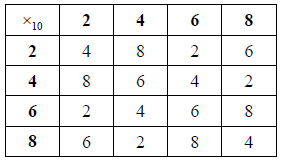
Show that {T, ×10} is a group. (You may assume associativity.)
By making reference to the Cayley table, explain why T is Abelian.
Find the order of each element of {T, ×10}.
Hence show that {T, ×10} is cyclic and write down all its generators.
The binary operation multiplication modulo 10, denoted by ×10 , is defined on the set V = {1, 3 ,5 ,7 ,9}.
Show that {V, ×10} is not a group.
Markscheme
closure: there are no new elements in the table A1
identity: 6 is the identity element A1
inverse: every element has an inverse because there is a 6 in every row and column (2−1 = 8, 4−1 = 4, 6−1 = 6, 8−1 = 2) A1
we are given that (modulo) multiplication is associative R1
so {T, ×10} is a group AG
[4 marks]
the Cayley table is symmetric (about the main diagonal) R1
so T is Abelian AG
[1 mark]
considering powers of elements (M1)
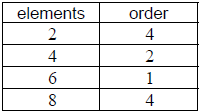 A2
A2
Note: Award A2 for all correct and A1 for one error.
[3 marks]
EITHER
{T, ×10} is cyclic because there is an element of order 4 R1
Note: Accept “there are elements of order 4”.
OR
{T, ×10} is cyclic because there is generator R1
Note: Accept “because there are generators”.
THEN
2 and 8 are generators A1A1
[3 marks]
EITHER
considering singular elements (M1)
5 has no inverse (5 ×10 a = 1, a∈V has no solution) R1
OR
considering Cayley table for {V, ×10}
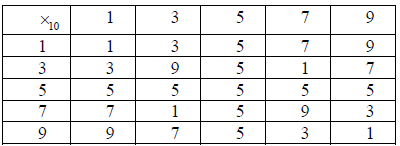 M1
M1
the Cayley table is not a Latin square (or equivalent) R1
OR
considering cancellation law
eg, 5 ×10 9 = 5 ×10 1 = 5 M1
if {V, ×10} is a group the cancellation law gives 9 = 1 R1
OR
considering order of subgroups
eg, {1, 9} is a subgroup M1
it is not possible to have a subgroup of order 2 for a group of order 5 (Lagrange’s theorem) R1
THEN
so {V, ×10} is not a group AG
[2 marks]